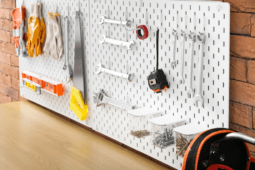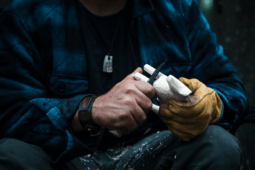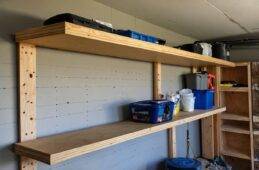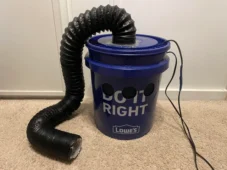DIY Concrete Fire Pit: How to Make a Concrete Fire Pit out of Mixing Bowls

There’s no doubt about the cheer. Beside your fire you live in a private, glowing little world. All around you, fire shapes dance across rocks and bushes and tree trunks…Most of the time, you just sit and gaze at the caverns that form and crumble and then form again and gaze into the caverns that form and crumble and then form again between the incandescent logs. You build fantastic worlds among those pulsating walls and arches and colonnades. You sit, in other words, and dream. The East African has an almost limitless capacity for this masterly and delightful form of inactivity, and when his friends see him squatting there, lost, they understand and say in Swahili, poetically, Anahota moto – “He is dreaming the fire.”
– Colin Fletcher, “The Complete Walker IV” (Knopf, NY: p. 288)
I don’t think there’s much more to say than that. So, let’s build our own DIY fire pit, yes? This version is made of affordable, weather-resistant concrete that creates a sleek, modern look. It’s portable but sturdy, and uses gel fuel, making it possible to have a quick 30-minute post grill session fire. It takes a bit of care and proper prep, but this could be made in just a few hours for well under $50 in materials.

Tools and Materials:
- Concrete mix
- One extra-large bowl for exterior mold (ours was 18″ diameter)
- One large bowl for interior mold (ours was 15″ diameter)
- Non-stick cooking spray, or vegetable oil and paintbrush
- Large bucket for mixing
- Medium-duty masonry trowel
- Proper safety gear for working with concrete:
- Dust mask for sanding and grinding
- Safety glasses or goggles
- Refinishing or work gloves
- Plastic or reusable drop cloth
- Heavy objects such as exercise weights (or you can use the rocks below)
- Sandpaper or sanding pad in coarse and fine grits
- Gel fireplace fuel canisters
- Replacement grill grate (ours was 14 1/2″ diameter)
- Fire-safe decorative stones
Casting the Bowl

Creating this project is all about two components: finding the right materials and working safely. For the main fire bowl, we used the largest mixing bowls we could find. Check your local restaurant or party supply store for extra-large options. I opted for a plastic punch bowl for the outside because I liked the profile shape, and a stainless steel mixing bowl for the inside.

Working with concrete isn’t difficult, but it does require some finesse. First, it’s fairly heavy and can be difficult to mix in large batches by hand. Secondly, it’s extra important to use the proper safety gear to prep and execute your project. Work outside or in a well-ventilated area, and cover your work surface with plastic. I covered my bench in a plastic drop cloth, and taped everything down with ScotchBlue™ tape.

Also, be sure to wear proper safety gear to protect your eyes, skin, and respiratory system. For this, I consulted with 3MDIY.com for their suggestions of the best products from their 3M Tekk Protection line. I went with an N95 valved dust mask for sanding and grinding, and long sleeves and refinishing gloves to protect my arms and hands. For my eyes, I opted for these Walter White-style safety goggles, which not only protect from debris but also dust and irritants. Plus, I prefer them when wearing a respirator or dust mask, since they seal tightly and don’t fog up.

1. Once you’re all prepped, spray your molds with non-stick spray. This will help release the concrete once it’s dry. A thin, even layer over the inside of the outer mold/outside of the inner mold will do.

2. Then, mix up your concrete. It’s hard to determine how much you’ll need, but it’s better to mix up more as you start than to rush to create more in the middle. I used about 1/3 of a bag for this project, adding water a little at a time until the mix formed a thick, cookie batter-like consistency. Make sure you’re wearing your safety gear here; this is the time when most of the particulates and irritants are flying around.

3. Then, use the trowel to add the concrete mix to the outer mold. Fill it about half full, then check the inner mold to see how high the concrete comes up to the side. It’s okay to take the inner mold in and out a few times, just make sure you don’t lose all your non-stick spray. (You can wipe it clean and reapply). A friend or extra pair of hands is helpful here. Then, use weights or rocks to keep it in place. Some things to watch out for:
- As you place the inner mold, make sure that it’s centered so your bowl will have an even thickness all the way around
- Keep the lips of the bowls coplanar for an even, symmetrical finished product
- Adjust the weights so that you have the biggest inner bowl as possible while keeping the structure thick enough to be strong. You’ll want to be sure that there’s enough space on the inside to place your gel canisters beneath the lip of the bowl.

4. For a super smooth finished surface, try this tip (I picked this up years ago from an episode of This Old House, I think): use something with a motor to vibrate the bowl to remove any air bubbles inside the mold. Here, I’m using my reciprocating saw without a blade, but anything will work: a powered sander, an oscillating or rotary tool, even an immersion blender.
One it’s settled and things are no longer moving, allow the concrete to cure according to the package directions. (48 hours-ish)
Finishing the Bowl

5. When your concrete has cured, carefully remove it from the mold. I lightly tapped on mine with a rubber mallet, first removing the inner bowl, then freeing the outer. It’s solid at this point, so don’t be afraid, but do be careful since it’s quite heavy.

6. Use a coarse sanding pad (60-80 grit) to clean up the top lip, and give everything a nice rounded profile. Again, since you’ll be generating a lot of fine particulate dust, wear your safety glasses, gloves, and dust mask.

Wipe away the debris, then give the whole thing a round of fine grit (220) sandpaper. Since concrete doesn’t have any fibers or grain like wood, you don’t have to work your way up. Any sanding is just the removal of irregularities or smoothing things up.
Assembling the Fire Pit

7. Lastly, take it outside, and place the gel fuel canisters inside. I found mine at a local fireplace/swimming pool/outdoor recreation store, but you can find them in some hardware or home improvement stores or online.

8. Place the grill grate in the bowl. The one I used was a 14.5″ bottom grate (for the charcoal, not the cooking surface) for a Weber kettle grill. It rested perfectly about 1/2″ from the surface of my 15″ internal diameter bowl. If you can’t find one, you can cut a larger one to size with a hacksaw or grinder, or create your own from hardware cloth or steel mesh.
9. Then, cover the grate with a layer of rocks. I’m using “Mexican beach pebbles” that I found at a garden center. These are commonly used with fire, so I can be sure they’ll stand up to the heat and won’t explode into flaming shrapnel with extended use. So, just be sure that whatever rocks you’re using are appropriate for the purpose.

Light It Up!
While the flames on these aren’t bonfire-sized, the gel canisters put out quite a bit of heat, and all kinds of fun ambiance. At some point, I’d like to make a few of these and place them around my patio or deck. (At some point, I’d also like to have a patio or deck). But, for about $40 in materials (many of which I can reuse), I have a great, easy-to-use backyard fire solution, that requires nearly zero work to start or snuff out, and can keep our outdoor hangouts going well past sundown.

Oh! And here’s a Pinterest/social media friendly image. Would you please be so kind and help share the goodness?

Enjoy!

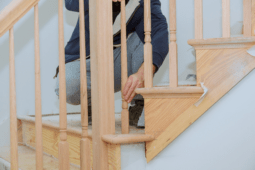
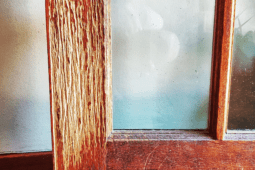

![How To Clean Patio Pavers [Without a Pressure Washer!]](https://www.manmadediy.com/wp-content/uploads/sites/52/2024/06/broom-15377-238x170.png)
